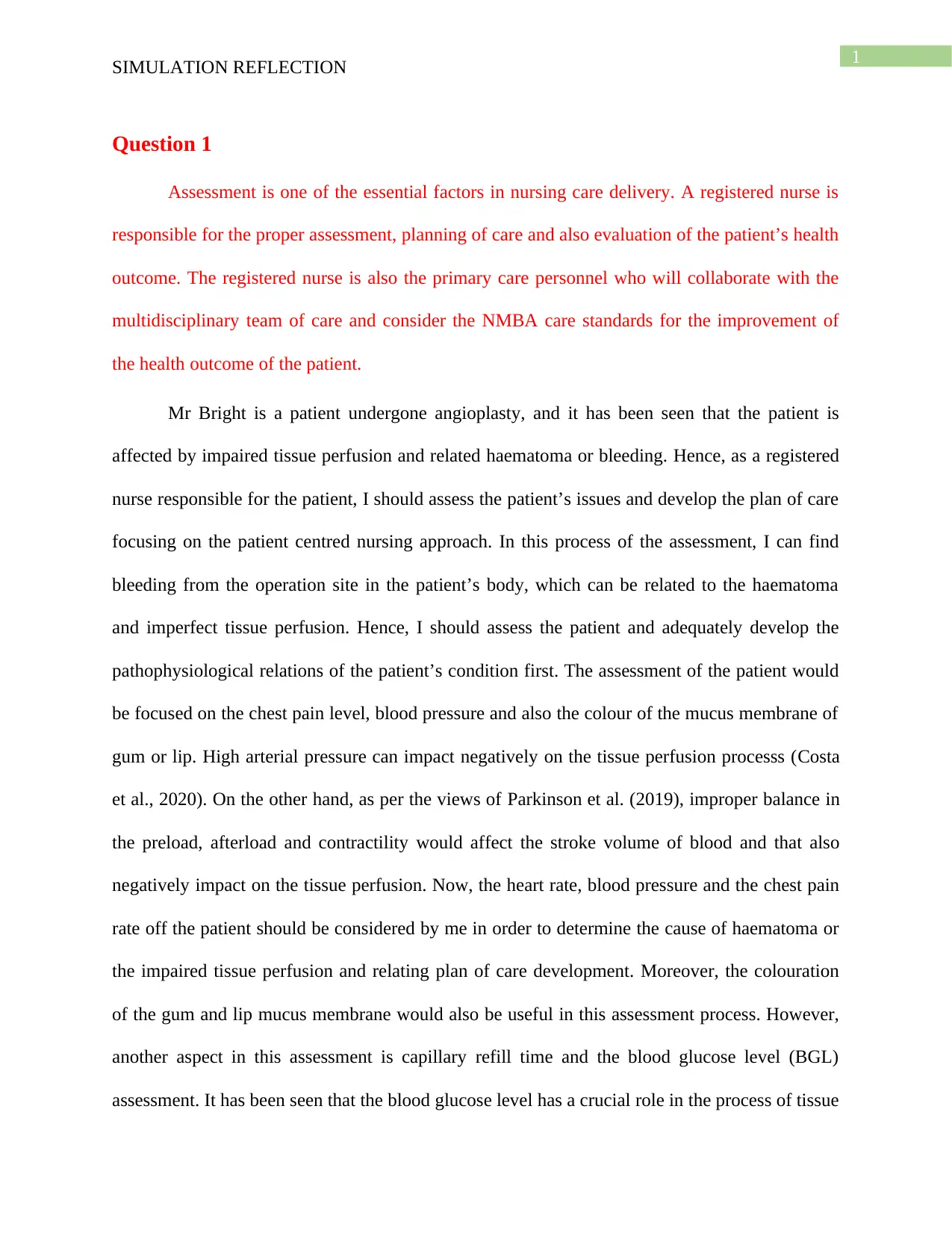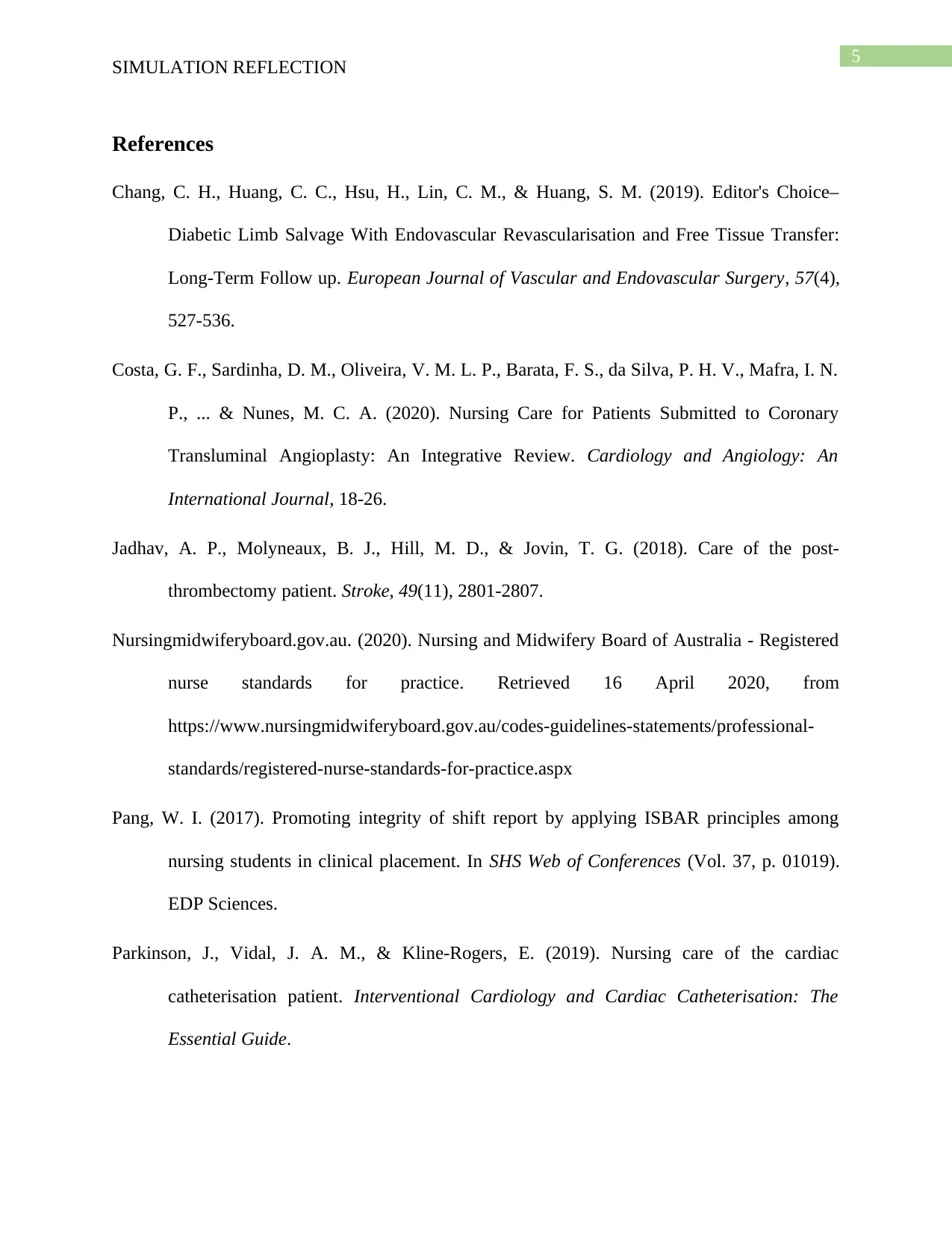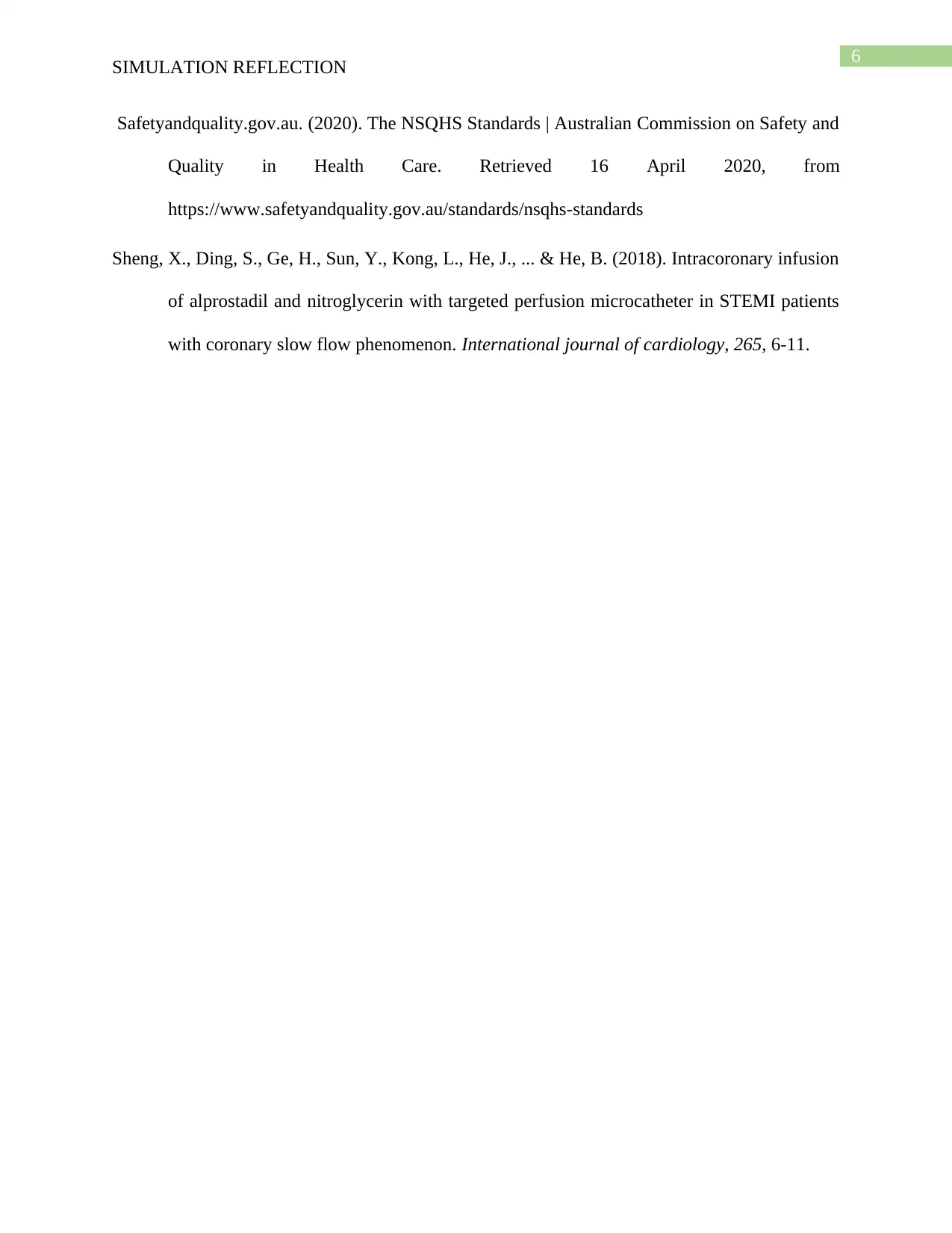NSB231 Simulation Reflection: Patient Assessment and Communication
VerifiedAdded on 2022/09/18
|7
|1546
|44
Report
AI Summary
This report presents a student's reflection on a nursing simulation centered around a patient, Mr. Bright, who underwent angioplasty and presented with impaired tissue perfusion and potential bleeding. The student, acting as a registered nurse, critically analyzes the assessment process, emphasizing the importance of considering factors like chest pain, blood pressure, and mucus membrane color, as well as capillary refill time and blood glucose levels. The reflection highlights the significance of adhering to NMBA care standards and patient-centered care approaches. Furthermore, the report discusses the ISBAR framework for effective communication during shift changes, underscoring its role in ensuring patient safety and care quality. The student identifies areas for improvement in their nursing competence, particularly in comprehensive patient assessment, and emphasizes the need for ongoing skill development to enhance patient care delivery.

Running head: SIMULATION REFLECTION
SIMULATION REFLECTION
Name of the Student
Name of the University
Author Note
SIMULATION REFLECTION
Name of the Student
Name of the University
Author Note
Paraphrase This Document
Need a fresh take? Get an instant paraphrase of this document with our AI Paraphraser

1
SIMULATION REFLECTION
Question 1
Assessment is one of the essential factors in nursing care delivery. A registered nurse is
responsible for the proper assessment, planning of care and also evaluation of the patient’s health
outcome. The registered nurse is also the primary care personnel who will collaborate with the
multidisciplinary team of care and consider the NMBA care standards for the improvement of
the health outcome of the patient.
Mr Bright is a patient undergone angioplasty, and it has been seen that the patient is
affected by impaired tissue perfusion and related haematoma or bleeding. Hence, as a registered
nurse responsible for the patient, I should assess the patient’s issues and develop the plan of care
focusing on the patient centred nursing approach. In this process of the assessment, I can find
bleeding from the operation site in the patient’s body, which can be related to the haematoma
and imperfect tissue perfusion. Hence, I should assess the patient and adequately develop the
pathophysiological relations of the patient’s condition first. The assessment of the patient would
be focused on the chest pain level, blood pressure and also the colour of the mucus membrane of
gum or lip. High arterial pressure can impact negatively on the tissue perfusion processs (Costa
et al., 2020). On the other hand, as per the views of Parkinson et al. (2019), improper balance in
the preload, afterload and contractility would affect the stroke volume of blood and that also
negatively impact on the tissue perfusion. Now, the heart rate, blood pressure and the chest pain
rate off the patient should be considered by me in order to determine the cause of haematoma or
the impaired tissue perfusion and relating plan of care development. Moreover, the colouration
of the gum and lip mucus membrane would also be useful in this assessment process. However,
another aspect in this assessment is capillary refill time and the blood glucose level (BGL)
assessment. It has been seen that the blood glucose level has a crucial role in the process of tissue
SIMULATION REFLECTION
Question 1
Assessment is one of the essential factors in nursing care delivery. A registered nurse is
responsible for the proper assessment, planning of care and also evaluation of the patient’s health
outcome. The registered nurse is also the primary care personnel who will collaborate with the
multidisciplinary team of care and consider the NMBA care standards for the improvement of
the health outcome of the patient.
Mr Bright is a patient undergone angioplasty, and it has been seen that the patient is
affected by impaired tissue perfusion and related haematoma or bleeding. Hence, as a registered
nurse responsible for the patient, I should assess the patient’s issues and develop the plan of care
focusing on the patient centred nursing approach. In this process of the assessment, I can find
bleeding from the operation site in the patient’s body, which can be related to the haematoma
and imperfect tissue perfusion. Hence, I should assess the patient and adequately develop the
pathophysiological relations of the patient’s condition first. The assessment of the patient would
be focused on the chest pain level, blood pressure and also the colour of the mucus membrane of
gum or lip. High arterial pressure can impact negatively on the tissue perfusion processs (Costa
et al., 2020). On the other hand, as per the views of Parkinson et al. (2019), improper balance in
the preload, afterload and contractility would affect the stroke volume of blood and that also
negatively impact on the tissue perfusion. Now, the heart rate, blood pressure and the chest pain
rate off the patient should be considered by me in order to determine the cause of haematoma or
the impaired tissue perfusion and relating plan of care development. Moreover, the colouration
of the gum and lip mucus membrane would also be useful in this assessment process. However,
another aspect in this assessment is capillary refill time and the blood glucose level (BGL)
assessment. It has been seen that the blood glucose level has a crucial role in the process of tissue

2
SIMULATION REFLECTION
perfusion (Chang et al., 2019). Thus, vital sign monitoring, BGL level assessment, pain or angina
assessment, mucus membrane colouration assessment and the capillary refill time assessment are
the effective assessment processes for the determination of the impaired tissue perfusion of the
patient in this case. Hence, as a registered nurse, I should adequately develop knowledge and
skills regarding these factors focusing on the pathophysiology as mentioned about the patient.
Based on the views of Sheng et al. (2018), I can also find that the nitro-glycerine administration
through the sublingual way can reduce the complaint of angina and it can also improve the
myocardial perfusion and the proper oxygen therapy maintenance can improve the situation for
the patient. Hence, I should effectively focus on the panning of the patient care based on the
effective assessment and the care plan development for the patient as well. I should focus on the
NMBA standards of care with utmost priority and develop the skills regarding patient centred
care approach. In this context, I can also state that the reflection on this simulation case helped
me in developing the knowledge regarding my nursing competences and I should improve the
competence more to provide effective care to the patients.
However, in this case, the mucus membrane colour assessment and the myocardial
infusion rate based on the capillary refill and the oxygen saturation rate of the patient has not
been assessed in this case simulation (Jadhav et al., 2018). I feel that the assessment process,
according to the patient’s condition, has not been followed all the possible assessment factors.
Hence, I should improve the competence of nursing care skills focusing on the patient centred
care delivery and patient safety along with care quality, as mentioned in the NMBA nursing care
standards (Nursingmidwiferyboard.gov.au, 2020). Moreover, the improvement of the situation
for the patient should be considered with higher priority and I should concern about the effective
factors of the patient assessment with overall focus on the patient’s physical and mental
SIMULATION REFLECTION
perfusion (Chang et al., 2019). Thus, vital sign monitoring, BGL level assessment, pain or angina
assessment, mucus membrane colouration assessment and the capillary refill time assessment are
the effective assessment processes for the determination of the impaired tissue perfusion of the
patient in this case. Hence, as a registered nurse, I should adequately develop knowledge and
skills regarding these factors focusing on the pathophysiology as mentioned about the patient.
Based on the views of Sheng et al. (2018), I can also find that the nitro-glycerine administration
through the sublingual way can reduce the complaint of angina and it can also improve the
myocardial perfusion and the proper oxygen therapy maintenance can improve the situation for
the patient. Hence, I should effectively focus on the panning of the patient care based on the
effective assessment and the care plan development for the patient as well. I should focus on the
NMBA standards of care with utmost priority and develop the skills regarding patient centred
care approach. In this context, I can also state that the reflection on this simulation case helped
me in developing the knowledge regarding my nursing competences and I should improve the
competence more to provide effective care to the patients.
However, in this case, the mucus membrane colour assessment and the myocardial
infusion rate based on the capillary refill and the oxygen saturation rate of the patient has not
been assessed in this case simulation (Jadhav et al., 2018). I feel that the assessment process,
according to the patient’s condition, has not been followed all the possible assessment factors.
Hence, I should improve the competence of nursing care skills focusing on the patient centred
care delivery and patient safety along with care quality, as mentioned in the NMBA nursing care
standards (Nursingmidwiferyboard.gov.au, 2020). Moreover, the improvement of the situation
for the patient should be considered with higher priority and I should concern about the effective
factors of the patient assessment with overall focus on the patient’s physical and mental
⊘ This is a preview!⊘
Do you want full access?
Subscribe today to unlock all pages.

Trusted by 1+ million students worldwide

3
SIMULATION REFLECTION
wellbeing. Hence, the improvement of the assessment skills should be considered and this
simulation reflection helped me in the identification of my lacks and I should develop the
competence regarding these lacks for the improved care delivery competence development.
Question 2
At time of shift changing of the nurse is responsible for communicating the information
regarding the assessment of the patient and also care plan of the patient to next shift nurse along
with a responsible doctor. Hence, as a registered nurse, I should follow the NMBA standards in
this factor as well as the National Safety and Quality Health Service Standards for Clinical
Handover (Safetyandquality.gov.au, 2020). In this context, I can state that the implementation of
the ISBAR framework for the verbal and documented information communication is
recommended for patient safety and care quality maintenance. The ISBAR framework stands for
the identify, situation, background, assessment and recommendation. In this case, the patient’s
chest pain complaint has been reported in the ISBAR format to the doctor. The identification,
situation and background of the pain based on the assessment data and the recommended care
procedure have been properly documented in the ISBAR format. In this way we could
effectively maintain the safety of the patient along with proper quality of the care process. I
should also state that the patient’s concern has been prioritised by informing the doctor about the
issue with consideration of the proper structured information communication. Thus, I can reflect
that the ISBAR is one of the most important and useful processes in terms of communicating the
patient information at the time of the transfer (Pang, 2017). As a registered nurse I should follow
the NMBA standards for the quality, safety and the patient and family centred care delivery for
the patient and also focus on the maintenance of the care continuum for the patient as well
(Nursingmidwiferyboard.gov.au, 2020). Hence, the ISBAR framework, along with the proper
SIMULATION REFLECTION
wellbeing. Hence, the improvement of the assessment skills should be considered and this
simulation reflection helped me in the identification of my lacks and I should develop the
competence regarding these lacks for the improved care delivery competence development.
Question 2
At time of shift changing of the nurse is responsible for communicating the information
regarding the assessment of the patient and also care plan of the patient to next shift nurse along
with a responsible doctor. Hence, as a registered nurse, I should follow the NMBA standards in
this factor as well as the National Safety and Quality Health Service Standards for Clinical
Handover (Safetyandquality.gov.au, 2020). In this context, I can state that the implementation of
the ISBAR framework for the verbal and documented information communication is
recommended for patient safety and care quality maintenance. The ISBAR framework stands for
the identify, situation, background, assessment and recommendation. In this case, the patient’s
chest pain complaint has been reported in the ISBAR format to the doctor. The identification,
situation and background of the pain based on the assessment data and the recommended care
procedure have been properly documented in the ISBAR format. In this way we could
effectively maintain the safety of the patient along with proper quality of the care process. I
should also state that the patient’s concern has been prioritised by informing the doctor about the
issue with consideration of the proper structured information communication. Thus, I can reflect
that the ISBAR is one of the most important and useful processes in terms of communicating the
patient information at the time of the transfer (Pang, 2017). As a registered nurse I should follow
the NMBA standards for the quality, safety and the patient and family centred care delivery for
the patient and also focus on the maintenance of the care continuum for the patient as well
(Nursingmidwiferyboard.gov.au, 2020). Hence, the ISBAR framework, along with the proper
Paraphrase This Document
Need a fresh take? Get an instant paraphrase of this document with our AI Paraphraser

4
SIMULATION REFLECTION
assessment knowledge and skills, are recommended factors. In this case simulation reflection, I
can find that the NMBA standards of care and the National Safety and Quality Health Service
Standards play a crucial role and I should follow them properly.
SIMULATION REFLECTION
assessment knowledge and skills, are recommended factors. In this case simulation reflection, I
can find that the NMBA standards of care and the National Safety and Quality Health Service
Standards play a crucial role and I should follow them properly.

5
SIMULATION REFLECTION
References
Chang, C. H., Huang, C. C., Hsu, H., Lin, C. M., & Huang, S. M. (2019). Editor's Choice–
Diabetic Limb Salvage With Endovascular Revascularisation and Free Tissue Transfer:
Long-Term Follow up. European Journal of Vascular and Endovascular Surgery, 57(4),
527-536.
Costa, G. F., Sardinha, D. M., Oliveira, V. M. L. P., Barata, F. S., da Silva, P. H. V., Mafra, I. N.
P., ... & Nunes, M. C. A. (2020). Nursing Care for Patients Submitted to Coronary
Transluminal Angioplasty: An Integrative Review. Cardiology and Angiology: An
International Journal, 18-26.
Jadhav, A. P., Molyneaux, B. J., Hill, M. D., & Jovin, T. G. (2018). Care of the post-
thrombectomy patient. Stroke, 49(11), 2801-2807.
Nursingmidwiferyboard.gov.au. (2020). Nursing and Midwifery Board of Australia - Registered
nurse standards for practice. Retrieved 16 April 2020, from
https://www.nursingmidwiferyboard.gov.au/codes-guidelines-statements/professional-
standards/registered-nurse-standards-for-practice.aspx
Pang, W. I. (2017). Promoting integrity of shift report by applying ISBAR principles among
nursing students in clinical placement. In SHS Web of Conferences (Vol. 37, p. 01019).
EDP Sciences.
Parkinson, J., Vidal, J. A. M., & Kline-Rogers, E. (2019). Nursing care of the cardiac
catheterisation patient. Interventional Cardiology and Cardiac Catheterisation: The
Essential Guide.
SIMULATION REFLECTION
References
Chang, C. H., Huang, C. C., Hsu, H., Lin, C. M., & Huang, S. M. (2019). Editor's Choice–
Diabetic Limb Salvage With Endovascular Revascularisation and Free Tissue Transfer:
Long-Term Follow up. European Journal of Vascular and Endovascular Surgery, 57(4),
527-536.
Costa, G. F., Sardinha, D. M., Oliveira, V. M. L. P., Barata, F. S., da Silva, P. H. V., Mafra, I. N.
P., ... & Nunes, M. C. A. (2020). Nursing Care for Patients Submitted to Coronary
Transluminal Angioplasty: An Integrative Review. Cardiology and Angiology: An
International Journal, 18-26.
Jadhav, A. P., Molyneaux, B. J., Hill, M. D., & Jovin, T. G. (2018). Care of the post-
thrombectomy patient. Stroke, 49(11), 2801-2807.
Nursingmidwiferyboard.gov.au. (2020). Nursing and Midwifery Board of Australia - Registered
nurse standards for practice. Retrieved 16 April 2020, from
https://www.nursingmidwiferyboard.gov.au/codes-guidelines-statements/professional-
standards/registered-nurse-standards-for-practice.aspx
Pang, W. I. (2017). Promoting integrity of shift report by applying ISBAR principles among
nursing students in clinical placement. In SHS Web of Conferences (Vol. 37, p. 01019).
EDP Sciences.
Parkinson, J., Vidal, J. A. M., & Kline-Rogers, E. (2019). Nursing care of the cardiac
catheterisation patient. Interventional Cardiology and Cardiac Catheterisation: The
Essential Guide.
⊘ This is a preview!⊘
Do you want full access?
Subscribe today to unlock all pages.

Trusted by 1+ million students worldwide

6
SIMULATION REFLECTION
Safetyandquality.gov.au. (2020). The NSQHS Standards | Australian Commission on Safety and
Quality in Health Care. Retrieved 16 April 2020, from
https://www.safetyandquality.gov.au/standards/nsqhs-standards
Sheng, X., Ding, S., Ge, H., Sun, Y., Kong, L., He, J., ... & He, B. (2018). Intracoronary infusion
of alprostadil and nitroglycerin with targeted perfusion microcatheter in STEMI patients
with coronary slow flow phenomenon. International journal of cardiology, 265, 6-11.
SIMULATION REFLECTION
Safetyandquality.gov.au. (2020). The NSQHS Standards | Australian Commission on Safety and
Quality in Health Care. Retrieved 16 April 2020, from
https://www.safetyandquality.gov.au/standards/nsqhs-standards
Sheng, X., Ding, S., Ge, H., Sun, Y., Kong, L., He, J., ... & He, B. (2018). Intracoronary infusion
of alprostadil and nitroglycerin with targeted perfusion microcatheter in STEMI patients
with coronary slow flow phenomenon. International journal of cardiology, 265, 6-11.
1 out of 7
Related Documents
Your All-in-One AI-Powered Toolkit for Academic Success.
+13062052269
info@desklib.com
Available 24*7 on WhatsApp / Email
![[object Object]](/_next/static/media/star-bottom.7253800d.svg)
Unlock your academic potential
Copyright © 2020–2025 A2Z Services. All Rights Reserved. Developed and managed by ZUCOL.





